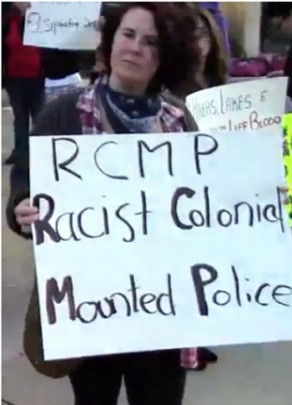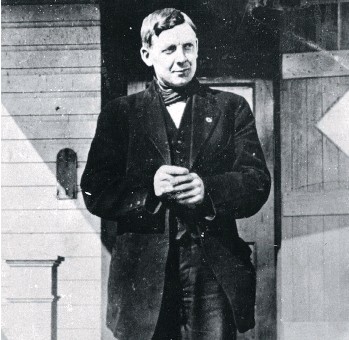
Made to Kill – The History and Role of Policing and Lethal Force in Canada
From the Critical Criminology Working Group, Surrey
Police kill. That is what they are formed and organized to do, and what they are tasked with doing by the state. When they kill it is not an aberration or error or misstep. It does not result from a lack of training—they are, after all, trained precisely to kill. It is a prerogative of the state’s monopoly on violence. Yet many people in Canada seem surprised by the extent of police killings, in those rare occasions when they are made aware of fatal police encounters. The media tends to underestimate the numbers of people killed by police and is overly ready to explain away police killings as somehow incidental, rather than structural features of repression and control in class society.
The excuses used are as familiar as they are bogus. They say “policing is dangerous” but it is not among the 10 most dangerous jobs in Canada. They refer to phony medical claims like excited delirium that have no basis in science. They speak of “suicide by cop” which is not suicide at all since cops have the choice not to kill. And they blame victims, as in a recent police-involved death in Surrey by saying the victim was “on something,” using stigmatizing language to absolve cops.
So it was that many expressed shock, even disbelief (though not so much outrage) when the Canadian Broadcasting Company (CBC) released its extensive documentation showing 460 people had died through police encounters in Canada between 2000 and 2017 in the investigative series Deadly Force. It is worth noting that the CBC even did the police a favor in under-counting police-involved death by arbitrarily deciding not to include among the numbers of victims any in-custody deaths (the second largest number in 2017) and car chase deaths. Research by criminologists with KillerCopsCanada shows at least 65 people died through police violence in 2017 and at least 23 as of April 19 in 2018.
A glance at the practice of policing in the Canadian state context shows that there should not be much surprise at the brutal, lethal actions of police at all levels. Police today are doing precisely what they were instituted and have been mobilized to do. This is what policing is all about in class society, even so-called liberal democracies like Canada.

The Always Militarized RCMP
The RCMP are the force that has been involved in the most police-involved deaths in Canada between 2000 to 2017. And they are the force responsible for the most deaths each year. RCMP were responsible for at least 118 deaths over the period researched by the CBC—more than two times as many as the next most lethal force, the Toronto Police Service.
The RCMP are active in communities at all levels in Canada. They serve as a federal force, provincial police, and municipal operation. The largest detachment in Canada is active right here in B.C., with the most officers deployed in any community in Canada being in Surrey, where I live and work.
The RCMP were founded explicitly as a military force of settler colonial occupation, dispossession, and displacement—a force of colonial genocide. While some remark on the so-called militarization of policing as a supposedly recent phenomenon, we should point out that the RCMP (and their predecessors, the North West Mounted Police and Royal North West Mounted Police) have always been a military force. Indigenous communities know this even if some settlers accept the myths.
Devised to occupy Indigenous lands and communities and to put down Indigenous resistance, the RCMP have also been deployed in imperialist adventures on behalf of the Canadian state and capital globally. The RCMP were deployed during the racist Boer War for British conquest of South Africa (which infamously introduced concentration camps by the British). Few may know that the RCMP also participated in the so-called Siberian Expeditionary Force of 1918, an overlooked part of Canadian state history which was explicitly a counter-revolutionary assault on the Russian working class and peasantry in Western capital’s early efforts to put down the Russian Revolution.
The RCMP have also been deployed as a force of military subjugation against working class uprisings and rebellions in Canada, including the Winnipeg General Strike in 1919, the Estevan miners’ strike of 1931, the On To Ottawa Trek of 1935, and numerous popular mobilizations against global capital since, including of course the 2010 anti-Olympics opposition in Vancouver and G7/G20 capitalist meetings in Kananaskis. In those twenty-first century cases military technology and infrastructures were used. In Kananaskis a shoot to kill order was issued.
If we are to speak honestly, the RCMP are a murderous, genocidal institution. That is their social foundation. That they continue to be the force most responsible for civilian deaths should be of no surprise. We should recognize it as a continuing fulfilment of their social role. This is how we need to view them whenever and wherever we encounter them in our neighbourhoods, on our streets, and in our communities.

Ginger Godwin
The murderous police repression of resistance
A key part of police function is putting down resistance to economic and political systems of power. While police killings of organizers and activists, as in Jackson State and Kent State universities and during urban uprisings in Watts, Detroit, and Newark, are documented and even familiar within U.S. culture, few Canadians know about the numbers of organizers and activists killed by police in Canada and the range of social and ecological issues for which police have killed, typically in the service of capital. While some names, like Dudley George, the unarmed Indigenous man killed by Ontario Provincial Police officer Tex Deane while reclaiming community lands might be familiar, most are not.
Socialist war resister and miner organizer Ginger Godwin was shot and killed in 1918 on Vancouver Island. Striking workers Mike Sokowolski and Mike Schezerbanowicz were shot and killed in Winnipeg during the General Strike in 1919. Striking miner William Davis was shot and killed in Nova Scotia in 1925. Striking workers were shot and killed in Estevan, Saskatchewan in 1931. Unemployed worker Nick Schaack was shot and killed in Regina in 1935. Striking lumber and sawmill workers Irenee Fortier, Joseph Fortier, and Fernand Drouin were killed at Reesor Siding, Ontario. Feminist and socialist Michele Gauthier was gassed to death in the streets of Montreal in 1971. In 2015 in British Columbia an Indigenous man, James McIntyre was shot and killed by RCMP for publicly opposing the Site C dam at a consultation event in Dawson Creek, with barely a ripple of outrage among the Canadian public, or even among activist circles.
These killings by police tell important parts of the history of resistance and repression in Canada. The people killed were struck down by police while seeking a better world than ours characterized by exploitation and oppression. And that is, fundamentally, the function of police—to stop this better world from being made.
Structures of inequality protected by police
That police disproportionately inflict lethal force on racialized people and communities, including Indigenous people and Black people in Canada, as the CBC Deadly Force research and the work of the community criminology project KillerCopsCanada show, is a reflection of the structural racism that Canada is founded on and relies on for division and conquest of the working class. More than that, violent police targeting of racialized and colonized people reinforces racist structures of inequality. It sends a social message about which lives can be subjected to violence. Because violence against certain bodies is treated as legitimate, from the state’s perspective, racialized victims of police violence are portrayed as deserving to die.
For example, Black people in Toronto made up 8.3% of the population over the 17 year period studied by the CBC, but were 37% of victims of police actions. In Winnipeg, Indigenous people made up about 10.6% of the population over that period but were nearly two-thirds of victims of police violence. As author Robyn Maynard has documented in the recent book, Policing Black Lives, the targeted violence of Black and Indigenous people is the original and ongoing character of the Canadian social system.
The state protects the state
We should not be surprised that the CBC analysis found that of all of the more than 460 police-involved deaths in Canada from 2000 to 2017, only 18 cases resulted in charges against the officers responsible. Or that, of these, only 2 resulted in convictions of the officers. The state protects the state.
Talk of oversight and reform of police must be approached in this context. Understanding the social role and function of police means recognizing that calls for reform or oversight will fail. When police kill, they are doing exactly what they were designed to do. From the perspective of power there is no problem with lethal police force unless it becomes too overt and threatens to fray the curtain of state ideology, showing the real violence of the state.
Addressing police violence in a serious way means abolishing police and developing community approaches to social care and safety that render police obsolete. Economic and political powerholders need police. We do not.
